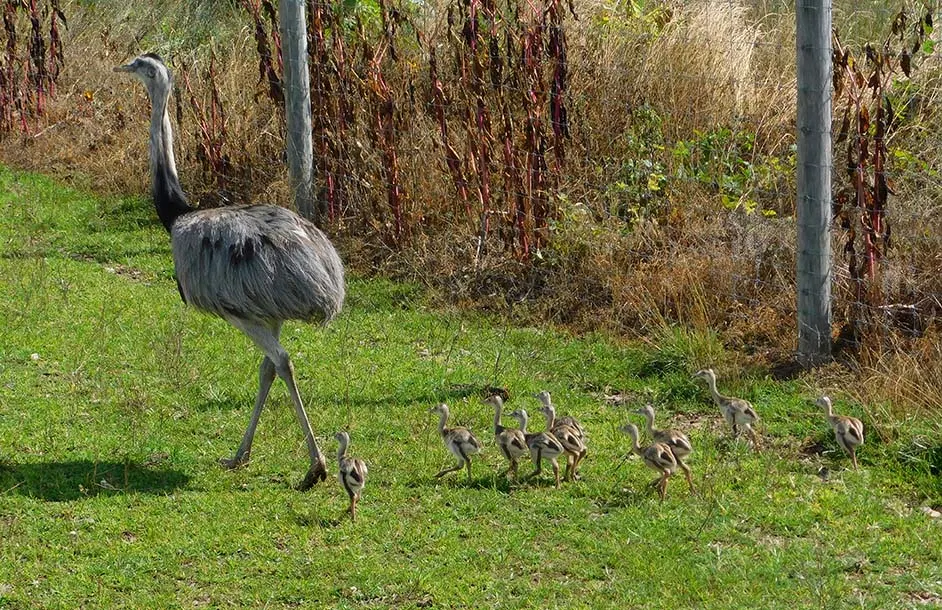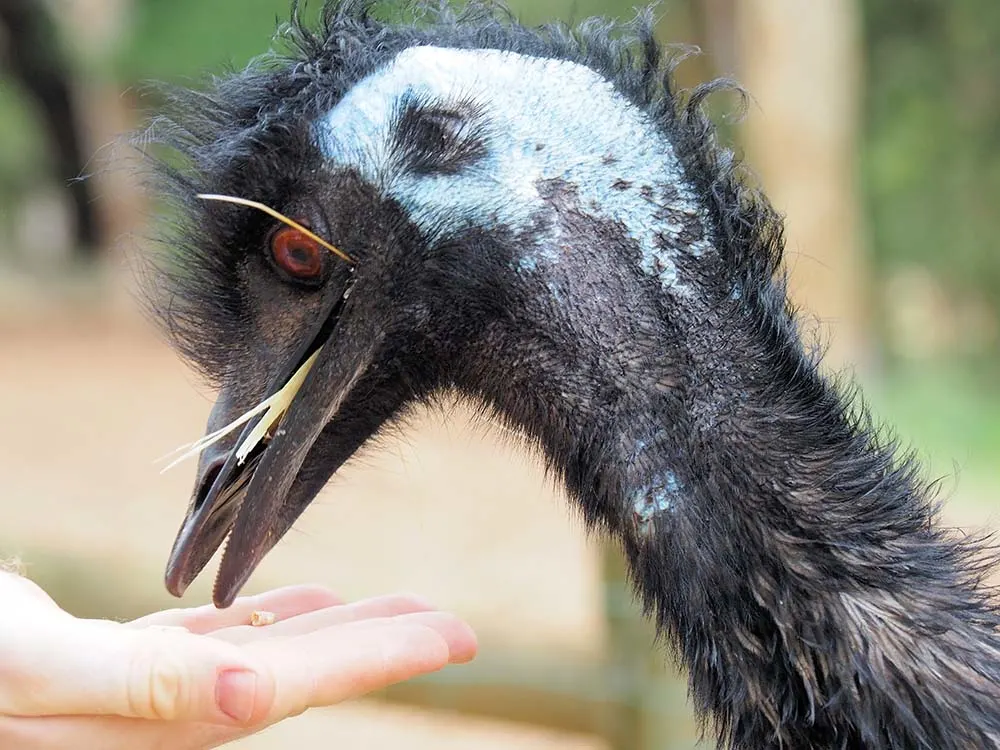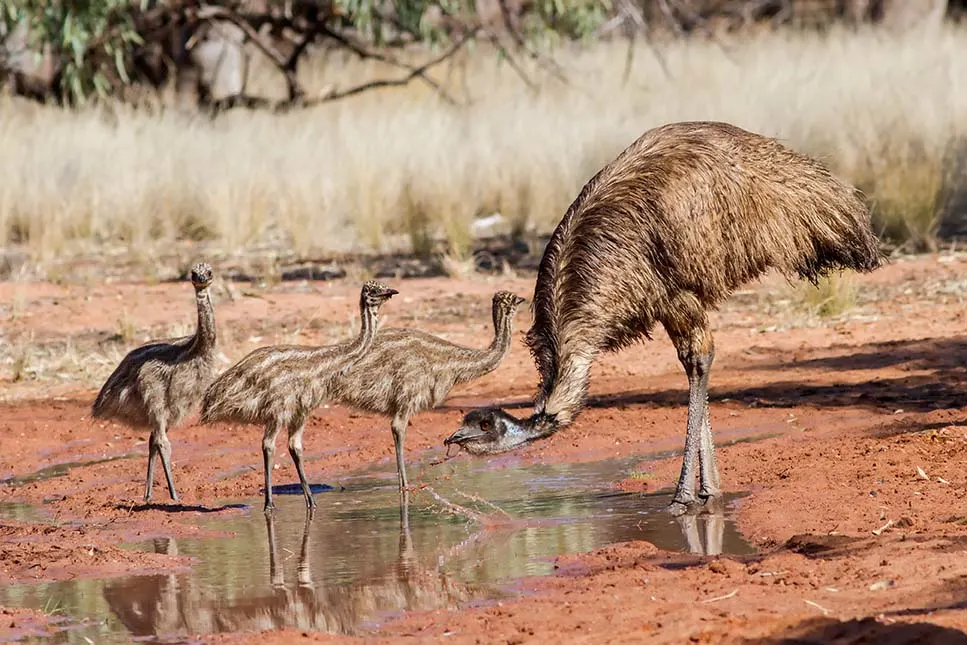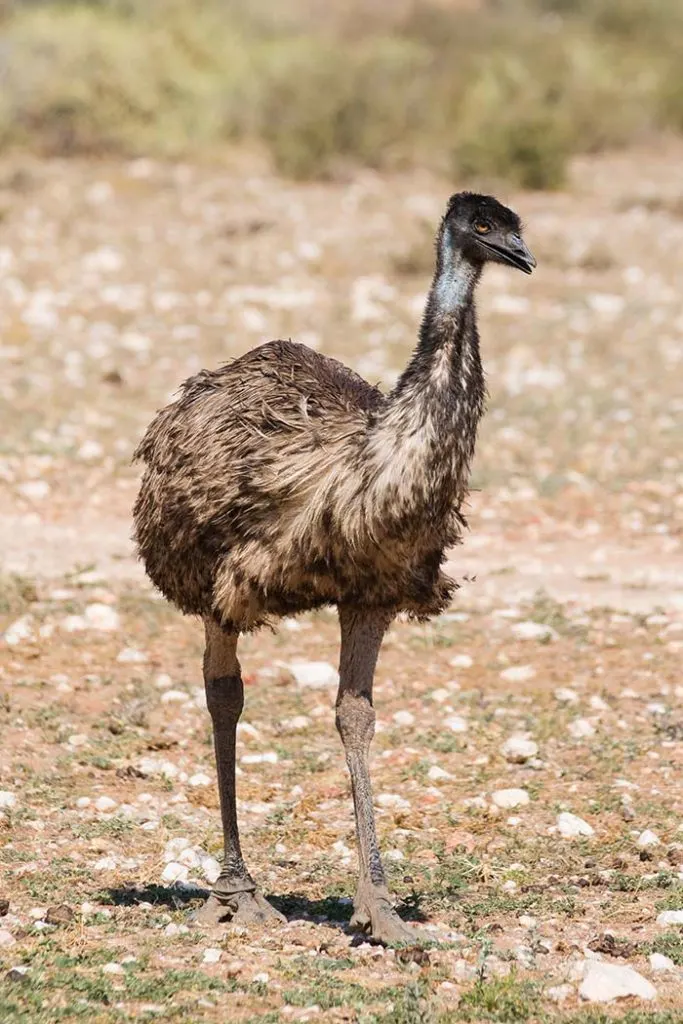Do your kiddos want to learn about emus? You've come to the right place! Check out these emu facts for kids.

Emus are large, flightless birds native to Australia. They are the tallest bird from Australia and the second tallest bird in the world, after the ostrich. The emu is also related to the cassowary which is slightly smaller but heavier.
Physical Description
The largest emus can reach 59 to 75 inches (150 to 190 cm) tall. Measured from bill to tail, emus range in length from 55 to 65 in (139 to 164 cm). Males average 58.5 inches (148.5 cm) and females average 61.7 inches (61.7 in). Emus weigh between 40 and 132 pounds (18 and 60 kg), with an average of 69 and 82 pounds (31.5 and 37 kg) in males and females, respectively. Females are usually slightly larger than males and are substantially wider across the rump.
Emus have pale blue necks and shaggy grey-brown plumage. The shafts and tips of their feathers are black. Emu bills are quite small, measuring 2.2 to 2.6 inches (5.6 to 6.7 cm) and are soft, being adapted for grazing.
They have good eyesight and hearing, allowing them to detect threats at some distance. Emus have vestigial wings, measuring around 8 inches (20 cm). Each wing has a small claw at the tip. Emus flap their wings when running, perhaps as a means of stabilizing themselves when moving fast. They have long necks and legs.
Their legs do not have feathers. Their feet have thick, cushioned pads, three toes with sharp claws on each foot. When walking, the emu takes strides of about 3.3 feet (100 cm), but at full gallop, a stride can be as long as 9 feet (275 cm). Emus can run at speeds of 30 mph (48 km/h).
Habitat
The Emu is found primarily in Australia. It lives throughout most of the continent, both inland and near the coast. However, they are most common in areas of savannah woodland and forest. The least common areas are heavily populated areas and arid areas with low annual precipitation.

Emus can travel long distances. For example, in Western Australia, emus have a seasonal pattern – to the north in the summer and to the south in the winter. On the east coast, emus will also travel but without any particular pattern.
Emus are also found in New Guinea, Indonesia, Solomon Islands, and the Philippines.
Habits
Emus are diurnal birds which means they are more active during the day. During the day they forage, preen their plumage with their beak, take dust baths and rest. Emus begin to settle down at sunset and sleep during the night.
When falling asleep, emus squat and enter a drowsy state during which they are alert enough to react to stimuli and quickly return to a fully awakened state if disturbed. As they fall into deeper sleep, their neck droops closer to the body and the eyelids begin to close. If there are no disturbances, they fall into a deeper sleep after about twenty minutes during which they fold into a small mound shape.
Emus will typically awaken from deep sleep about every ninety minutes or so and stand upright to feed briefly or defecate. This period of wakefulness lasts for ten to twenty minutes, after which they return to slumber.
Emus make grunting sounds and have an inflatable throat pouch capable of making booming sounds. The vocalizations of emus mostly consist of various booming and grunting sounds. Most of the booming is done by females.
They are able to swim if necessary but rarely do so unless the area is flooded or they need to cross a river.
Diet
Emus are omnivores. They’re diet depends on seasonal availability but they eat seeds, fruit, bark, nuts and stems. The Acacia, Casuarina and grasses are favorites. They also eat insects, small reptiles, amphibians and other small animals. Insects provide a large portion of their protein requirements. Emus also feed on wheat, and any fruit or other crops that they can access and can easily climb over high fences.

Captive emus will eat almost anything. They have been known to eat shards of glass, marbles, car keys, jewelry, and nuts and bolts.
Emus drink infrequently, but will ingest large amounts of water when the opportunity arises. They typically drink once a day and, if not disturbed, may drink for ten minutes. But due to scarce water sources, emus are sometimes forced to go several days without water.
Offspring
Emus form breeding pairs during the summer months of December and January and may remain together for about five months. Female court the males. Their plumage darkens slightly and the small patches of bare, featherless skin just below the eyes and near the beak turn turquoise-blue. The females stride around, pulling their neck back while puffing out their feathers and emitting low calls that sound similar to a drum beat.
Mating usually takes place between April and June. Males will construct a rough nest in a semi-sheltered hollow on the ground, using bark, grass, sticks and leaves to line it. The female lays 5 to 15 eggs, called a clutch of eggs, over several days. The eggs are light green and turn darker green as they get closer to hatching. When finished, the female often wanders off, leaving the male to incubate the eggs. Females can mate several times every season and lay several clutches of eggs in one season.

Because the emu is able to store fat very efficiently, they can go for a very long time without food, permitting the males to incubate the eggs over a 48-to-56-day incubation period. During the incubation period, he does not eat or drink and loses up to one-third of his body weight. He stands only to turn the eggs about 10 times per day.
Newly hatched emus are called chicks. Chicks are cream-colored with dark brown stripes. They are about 5 inches (12 cm) tall at first, weigh about 17.6 ounces (0.5 kg). They can walk within minutes of hatching and are able to leave the nest at about 3 days old. Chicks are cared for by the male for four to six months. They are full-grown at 12 to 14 months and usually stay with the male until about 18 months old. Emus don’t reach sexual maturity until about 2 years of age.
Classification/Taxonomy
Kingdom: Animalia
Subkingdom: Bilateria
Infrakingdom: Deuterostomia
Phylum: Chordata
Subphylum: Vertebrata
Infraphylum: Gnathostomata
Superclass: Tetrapoda
Class: Aves
Order: Casuariiformes
Family: Dromaiidae
Genus: Dromaius Vieillot
Species: Dromaius novaehollandiae
History
Emus have existed on the plains of Australia for about 80 million years.
The emu has been an important source of meat to Aboriginal Australians. They used the fat as bush medicine and rubbed it into their skin. It served as a valuable lubricant, was used to oil wooden tools and utensils, and was mixed with ochre to make a traditional paint for ceremonial body adornment.

Predators
The primary predators of emus are dingos and wedge-tailed eagles.
Snakes and other nest-raiders will eat emu eggs.
To protect themselves from predators, the emu’s main defense is a swift kick or two with their powerful legs. The emu has sharp claws on its toes which are used in combat to inflict wounds when kicking.
Lifespan
The lifespan of emus is 10 to 20 years in the wild and up to 35 years in captivity.
25 Unusual Facts about Emus
- Although the population of emus on mainland Australia is thought to be higher now than it was before European settlement, some local populations are at risk of extinction.
- A unique feature of the emu feather is the double rachis, or spine, emerging from a single shaft.
- Emus can jump 7 feet (2.1 meters) straight up in the air.
- Emus swallow small stones (called gastroliths or gizzard stones) which stay in the gizzard and help grind up food.
- While usually solitary, emus can form enormous migratory flocks. Flocks will often travel long distances for food and water.
- Although not very social, emus have a curious and docile nature.
- Emus can emit a bloodcurdling hiss which is effective at warning off dingoes.
- An emu’s body contains 3 gallons (13.5 liters) of oil. Emu oil is used in lotions, soaps, shampoo, and health care products.
- The emu is popularly, but unofficially, considered the national bird of Australia.
- Like the kangaroo, emus cannot back up.
- Over 600 places in Australia are named after the emu in their title, including mountains, lakes, hills, plains, creeks and waterholes.
- The emu has a prominent place in Australian Aboriginal mythology, including a creation myth of the Yuwaalaraay and other groups in New South Wales who say that the sun was made by throwing an emu’s egg into the sky.
- Emus are the only birds that have calf muscles.
- Their greyish-to-brownish body feathers provide almost complete protection from solar radiation.
- Humans farm emus for their meat and eggs. One emu egg can make an omelet big enough to feed four to six adults.
- The first occurrence of identical bird twins was discovered in the emu.
- The name 'emu' may have been derived from an Arabic word for large bird and later adopted by early Portuguese explorers and applied to cassowaries in eastern Indonesia. The term was then transferred to the Emu by early European explorers in Australia.
- The emu population around Australia is estimated to be around 600,000 to over 700,000. Nationally they're classified as ‘of least concern'.
- Unlike most birds, their flat breastbones lack the keel that anchors the strong pectoral muscles required for flight.
- The emu’s inner plumage insulates the skin. This prevents the birds from overheating, allowing them to be active during the heat of the day.
- Translucent, secondary eyelids that move horizontally from the inside edge of the eye to the outside edge function as visors to protect the eyes from the dust that is prevalent in windy arid regions.
- In 1932, the Australian military was deployed to kill a group of 20,000 emus who were damaging wheat farms while searching for water. However, the soldiers were recalled after a very unsuccessful week as emus are quite resourceful in dodging attacks.
- Some farmers see emus as beneficial because they eat the burrs that entangle sheep as well as nuisance insects like caterpillars and grasshoppers.
- To find water, emus primarily rely on the sight of rain clouds. They may use clues like the sound of thunder or the scent of wet ground.
- When the emu defecates, they leave and scatter seeds behind them which may then grow in fertile soil.
Check out these other cool birds!
